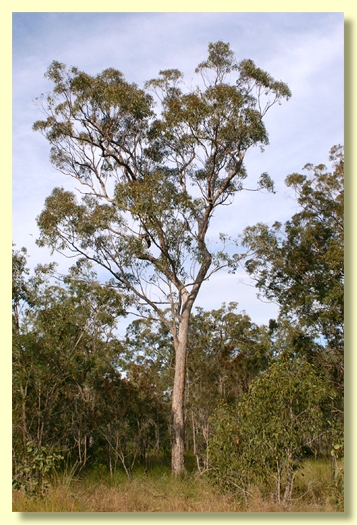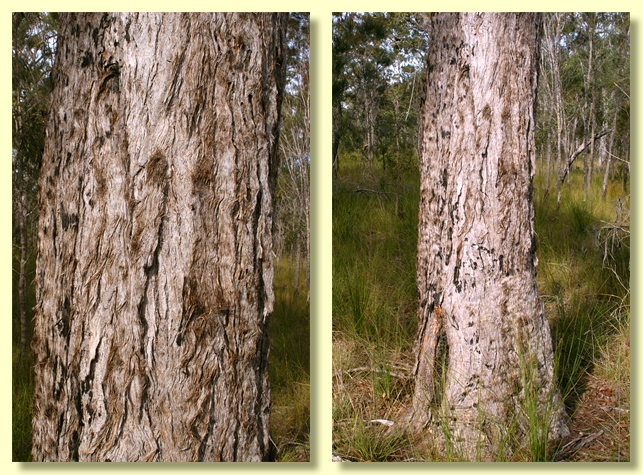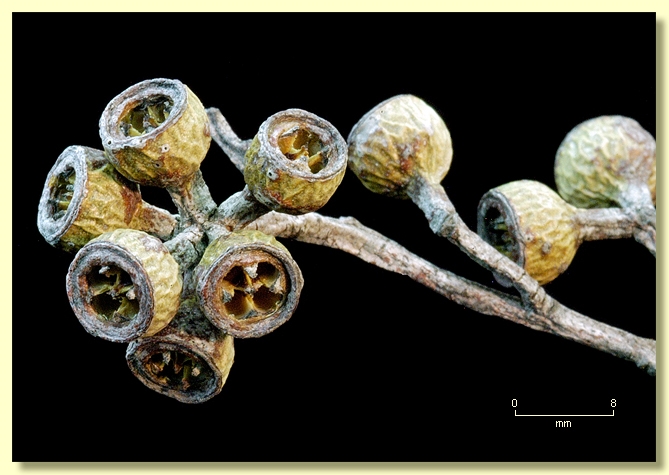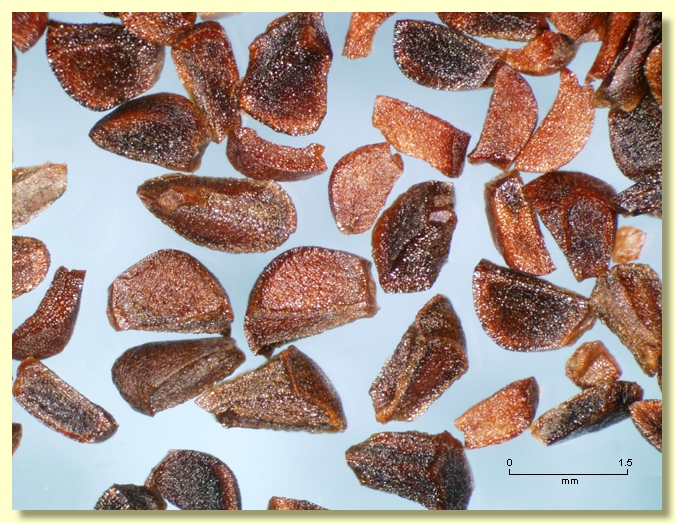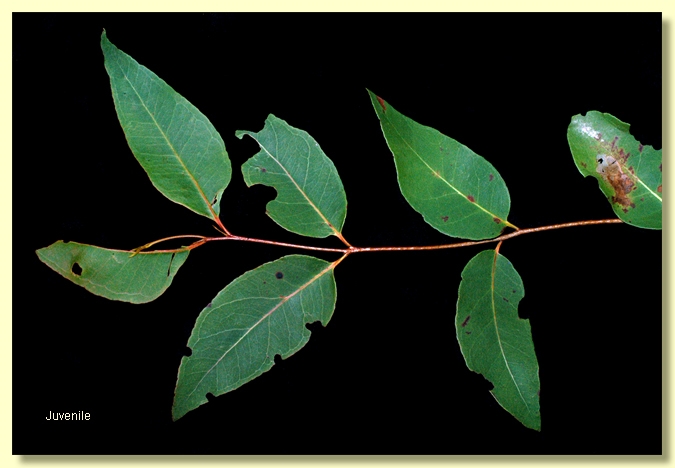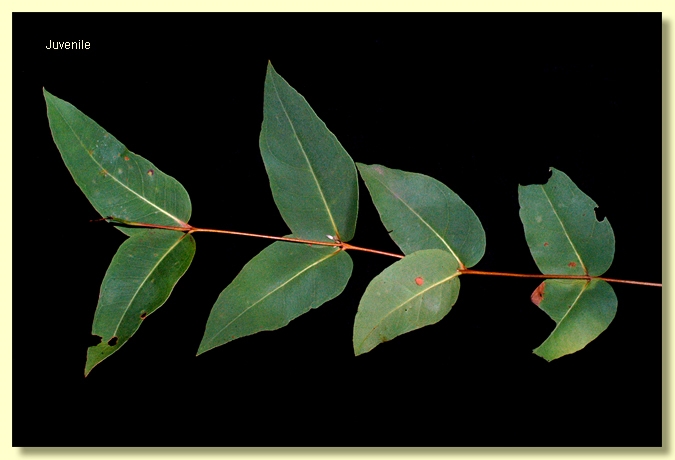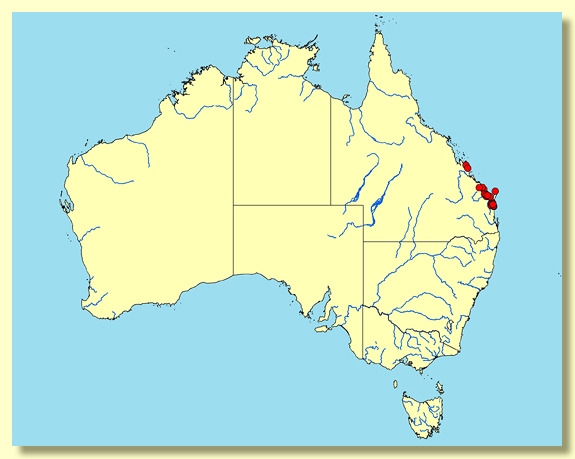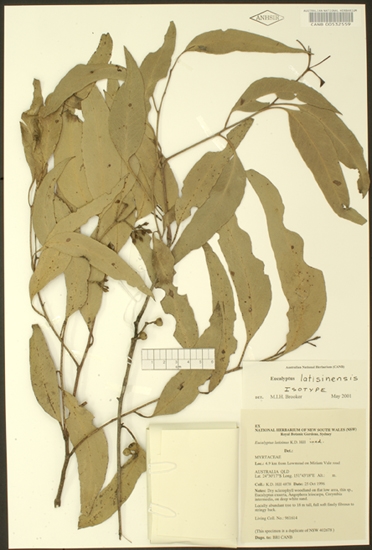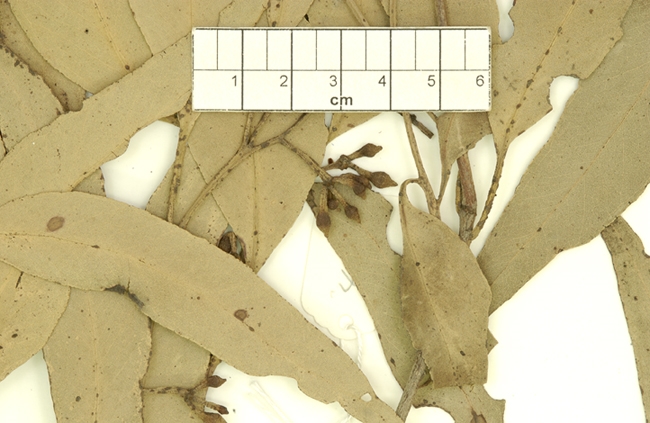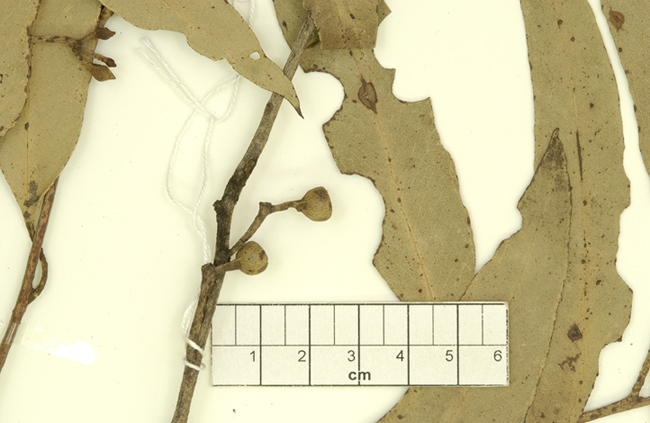Euclid - Online edition
Eucalyptus latisinensis
Eucalyptus | Eucalyptus | Amentum
Eucalyptus latisinensis K.D.Hill, Telopea 8: 244 (1999).
T: Queensland: 4.9 km from Lowmead on Miriam vale road, 25 Oct. 1996, K.D.Hill 4878; holo: NSW; iso: BRI, CANB.
Tree to 18 m tall, sometimes widely spreading. Forming a lignotuber.
Bark rough to small branches, soft and finely fibrous to stringy, grey or grey-brown.
Juvenile growth (coppice or field seedlings to 50 cm): stem rounded in cross-section; juvenile leaves sessile and opposite for the first few nodes with the lamina held horizontally, then becoming alternate and petiolate (petioles to ca 1 cm long) with lamina held vertically, broadly elliptical to ovate to broadly lanceolate, 5–15 cm long, 3–7 cm wide, base never amplexicaul, but shallowly lobed to rounded to truncate or tapering, discolorous becoming concolorous green, dull.
Adult leaves coarsely textured, alternate, petiole 1–2.2 cm long; blade lanceolate to falcate, 6–16 cm long, 1–4 cm wide, base tapering to petiole, margin entire, apex pointed, concolorous, slightly glossy or dull, green, side-veins at ca 40° to 50° to midrib, moderately to very densely reticulate or reticulation obscure because of leaf thickness, intramarginal vein remote from margin, oil glands island, intersectional or obscure.
Inflorescence axillary unbranched or sometimes aggregated near ends of branchlets and thus appearing like a terminal panicle, peduncles 0.8–1.5 cm long, buds 7 to ?15 per umbel, pedicels 0.3–0.6 cm long. Mature buds ovoid, 0.4–0.6 cm long, 0.3–0.4 cm wide, green to yellow, scar absent, the single operculum shed at flowering, operculum conical to beaked, stamens irregularly flexed, anthers reniform to cordate, versatile, dorsifixed, dehiscing by confluent slits, style long, stigma tapered, locules 4 or 5, the placentae each with 2 vertical ovule rows; flowers white.
Fruit pedicellate (pedicels 0.2–0.7 cm long), truncate-globose to hemispherical, 0.3–0.7 cm long, 0.5–0.9 cm wide, always flat-topped and wider than long, disc flat and placed at or just below rim level, valves 4 or 5, at disc level or slightly exserted beyond this.
Seeds brown, 1–2 mm long, pyramidal or obliquely pyramidal, dorsal surface usually smooth, hilum terminal.
Cultivated seedlings (measured at ca node 10): cotyledons reniform; stems rounded in cross-section; leaves opposite for ca 10 nodes then alternate, sessile or just starting to develop a petiole at node 10, ovate, 8–9 cm long, 3–4 cm wide, base amplexicaul, discolorous, green.
Flowering has been recorded in August.
A woodland tree endemic to Queensland and found along the coast from near Yeppoon south to Brisbane and also on Fraser Island. It is frequently found in areas of Wallum (heath) or in woodlands on flats, always on deep sands which may be seasonally waterlogged. Eucalyptus latisinensis is distinguished by its extensive rough finely fibrous bark, more or less thickish, concolorous, dull, green adult leaves with densely reticulate venation, and hemispherical fruit with flat disc. Juvenile leaves are ovate and become alternate and shortly petiolate after very few nodes.
Within its natural range Eucalyptus latisinensis is likely to be confused with similarly fibrous-barked species, especially the stringybarks and other species of white mahogany.
All species of stringybark have adult leaves with sparsely reticulate venation and a quick inspection of fresh leaves against strong sunlight will be informative. In addition stringybarks have furrowed bark with much longer "stringy" fibres, thicker-walled fruit with prominent disc and juvenile leaves that are scabrid/hairy at the lower nodes at least.
White mahogany species with geographic ranges overlapping with Eucalyptus latisinensis are E. carnea and E. acmenoides. The latter prefers wetter forest types and is distinguished by its strongly discolourous and thin-textured adult leaves and fruit that frequently have a concealed disc. Eucalyptus carnea is more troublesome to distinguish because it has similar adult leaves to E. latisinensis. The fruit of E. carnea are of similar size but with a narrower disc that is often descending rather than flat, a weak distinction, and its juvenile leaves remain opposite for ca eight nodes before becoming alternate, compared with E. latisinensis, which that has flat-topped fruit with a broad disc and slightly narrower juveniles variably becoming alternate from node two or later.
MORE ABOUT WHITE MAHOGANIES
Eucalyptus latisinensis : Latin latus, wide and -ensis, inhabitant of, referring to the natural distribution of this species in the Wide Bay area of Queensland.

